The tricky thing though, is that you won’t find Ravenswood on a map of Chicago’s 77 officially recognized community areas. Ravenswood doesn’t really even have agreed upon boundaries; some people (especially realtors) conflate it with the Lincoln Square community area. So, what is it that makes Ravenswood a true place, somewhere with an identity?
There are two main unique factors at play that differentiate Ravenswood from other nearby neighborhoods: Ravenswood Avenue and the East Ravenswood Historic District. The historic district is recognized on the National Register of Historic Places and is bound by Irving Park on the south, Clark to the east, Lawrence to the north, and Ravenswood Avenue on the west. Obviously, Ravenswood Avenue extends further south and north into different neighborhoods such as Bowmanville and West Lakeview, but it has a very consistent character between Irving Park and Lawrence, with very little residential use and a whole lot of industrial, commercial, and mixed uses: these include everything from tech companies, theaters, restaurants, breweries, designers, and artists to non profits, professional services, artisans, wholesalers, manufacturers, industrial designers, and many others. This dichotomy between a gritty and eclectic post-industrial commercial corridor and wonderfully spacious, lush, and classical residential streets creates a distinct feeling to Ravenswood.
History
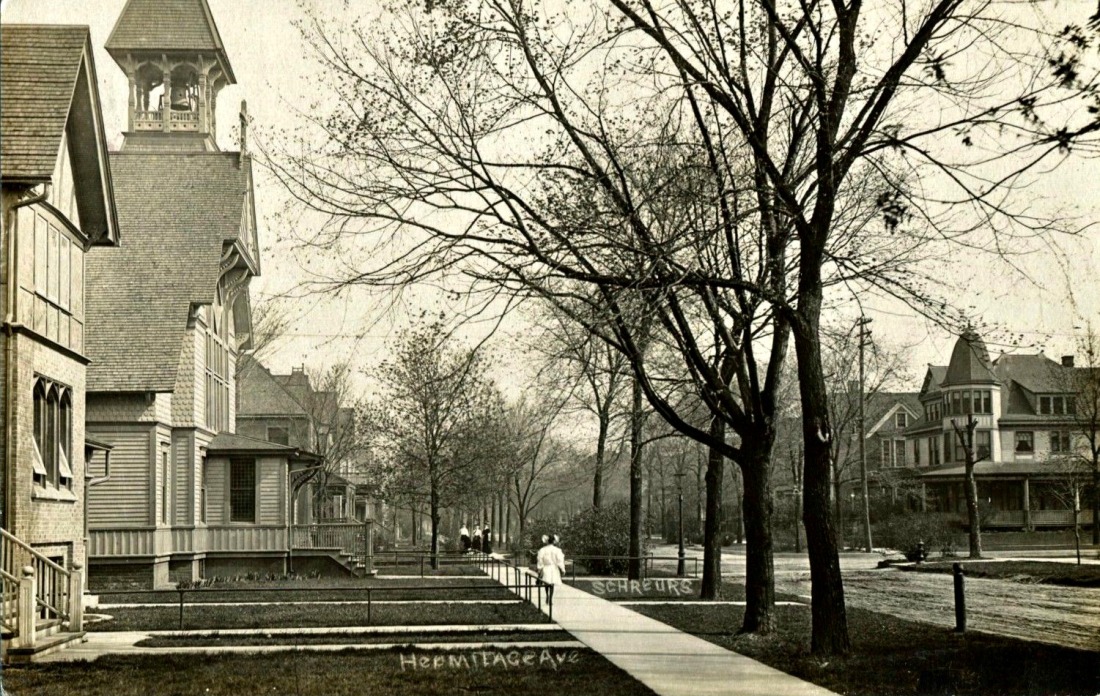

Ravenswood, particularly the East Ravenswood Historic District, is important because it was planned as one of Chicago’s first suburbs to function as a completely independent community. Additionally, it is notable for its varied residential and institutional architectural styles and building types.
According to the National Register for Historic Places, the East Ravenswood Historic District is significant for its association with the development of transportation, the growth of the region following the Great Fire of 1871, the rapid influx of immigrants, the changes to the city caused by the World’s Columbian Exposition of 1893, and the growth of industry in the late 19th and early 20th centuries. It is also notable for its physical setting and building stock, which are both representative of the aforementioned transitions in Chicago’s history. The character of this area and its built environment have remained relatively unchanged to this day.
In 1837, Conrad Sulzer and his family, who were Swiss immigrants, purchased 100 acres of undeveloped land which would later become Ravenswood. Other folks eventually settled nearby and established farms around the Sulzer farmstead. The Sulzer’s are recognized as the first recorded non-native settlers in the area.

Back in I860 when Graceland Cemetery was chartered, the surrounding town of Lake View was still mostly rural. In 1868, after Graceland was founded, a group of South Side businessmen formed the Ravenswood Land Company and purchased 194 acres to develop a subdivision in the still fairly undeveloped area north of Chicago. This original plot of land was located adjacent to the northwest corner of Graceland Cemetery, starting at Clark and Sulzer Road (now Montrose Avenue). This subdivision was generally bound by present day Lawrence on the north, Damen on the west, Clark on the east, and Montrose/Berteau on the south.
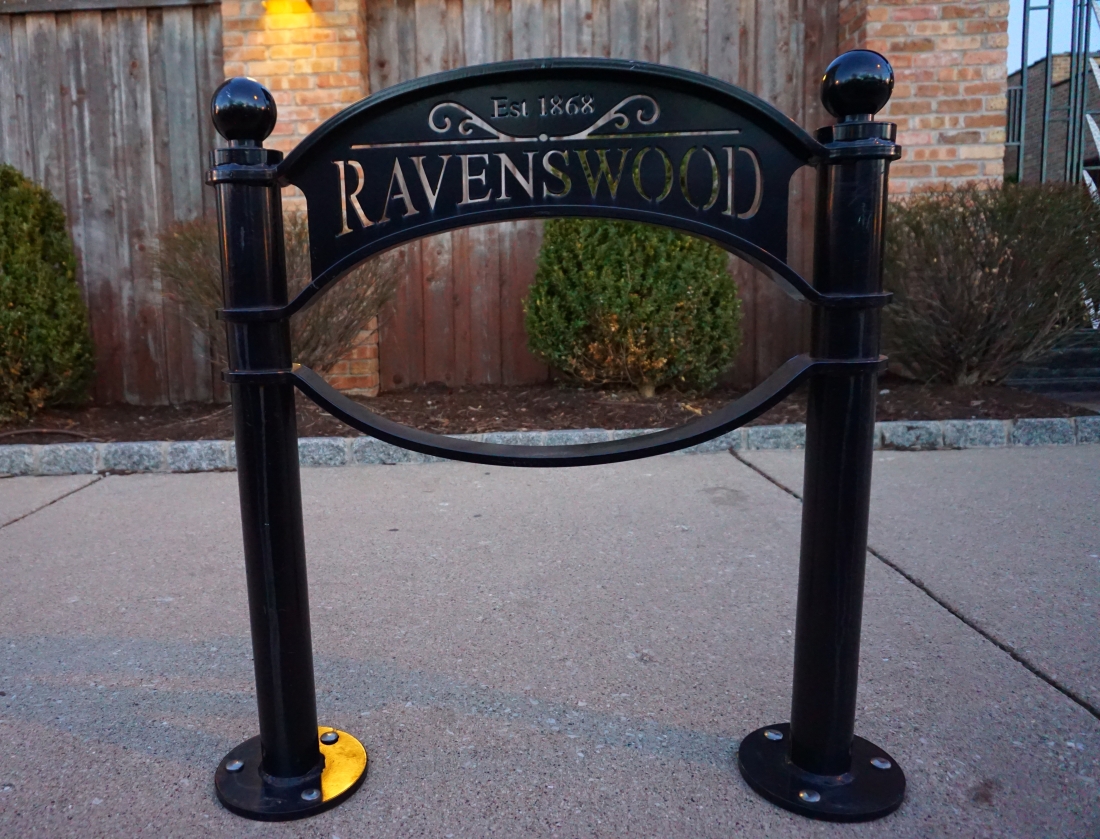
The Great Chicago Fire in 1871 served as an incredibly important moment for the expansion of Ravenswood. Following the fire, many people moved to Ravenswood and the surrounding areas for a place to rebuild their homes and start their lives over again. Folks chose to relocate to Ravenswood for a couple of reasons. First, many working-class people sought an area where they could build wood frame houses because they couldn’t afford to comply with new fire safety construction codes in Chicago. But it wasn’t only working-class people seeking refuge in Ravenswood, middle-class people also built houses in the area. The diversity of economic backgrounds of early homeowners in Ravenswood is still evident as modest frame cottages can be found next to grand mansions.
Secondly, due to the rebuilding of Chicago and the increase in building north of the city after the fire, the brickyards along the north branch of the Chicago River drew many immigrants, specifically German, to the surrounding area. Bricks were increasingly valuable to comply with new fireproof construction laws. As more immigrants moved to Chicago and the areas north of the city, the farms that occupied the area began to disappear. Through additions to the subdivision of Ravenswood, by 1890 the boundaries expanded to Leavitt, Berteau, Clark, and Lawrence.





It is not quite known why the name Ravenswood was selected for the subdivision in the first place. There are a few different theories: some say that the community was named after Chief Raven, a Native American who had lived nearby in a densely wooded area of the region now called Bowmanville. Others speculate that Ravenswood was named for the abundance of ravens which lived in the woods nearby. Another theory is that it was the name of a town in the Eastern United States that one of the settlers once lived in. Perhaps the most interesting theory is that it was named after a character in the novel “The Bride of Lammermoor” which was written by Sir Walter Scott in 1819. Even if the origin of the name Ravenswood has been lost over the course of history, it has proved popular enough to live on throughout the years.
Ravenswood Avenue
The beating heart of the neighborhood is its namesake street which has historically served as the “main street” for the community. By the 1870’s and 1880’s Ravenswood Avenue was a local business district with grocery stores, a meat market, a post office, and a drug store, among other shops and offices. But the street also had lumber yards and commercial stables north of Wilson Avenue. There were generally three waves of development for Ravenswood Avenue as a commercial and industrial corridor: the first being right after the Chicago and Northwestern railroad was established in 1855, the second occurring after the extension of the elevated train in the first decade of the 20th century, and the third beginning during World War I.
The Ravenswood Avenue corridor first started as a business district, but by the 1890’s it started to transform into a light manufacturing corridor. This was due to the fact that people began to take advantage of the railroad along the street which offered an easy way for goods to be transported, and also because land was affordable. The development of industry along the corridor facilitated the growth of residential uses nearby. As more people came to the area to live and work, the elevated railroad was extended to Ravenswood in 1907, with stations at Irving Park, Montrose, Ravenswood, and Damen serving the surrounding area.

The construction of the Ravenswood branch of the Northwestern Elevated train line, which began service on May 18, 1907, brought with it an increase in industrial and light manufacturing to the corridor. The Ravenswood station, which no longer exists, was typical of the elevated stations built for the Ravenswood branch except that the station was situated mid-block, just south of Wilson Avenue rather than being located at a cross-street with the station house under the elevated structure. The station was most likely located here because the Ravenswood station on the Chicago & North Western Railroad was originally located south of Wilson Avenue, across from the elevated station’s location. Interestingly, the Ravenswood station, with commuter service now operated by the Union Pacific on behalf of Metra, was later relocated two blocks north between Leland and Lawrence.





Thankfully, many of the industrial buildings in the corridor from that time still exist. For example, 4335 N. Ravenswood, which was once occupied by the Boye Needle Company. The company was founded in 1905 by John L. Flannery, and was located on Wabash Avenue between Randolph and Washington Streets but relocated to 4335 N. Ravenswood after the original building was destroyed by fire. By 1918, they employed 150 people in the manufacturing of sewing machine supplies, hardware, and dry goods novelties. This building now houses the neighborhood gem Architectural Artifacts.
Starting in the 1970s, Ravenswood Avenue began to slowly evolve from its industrial past into a center for cultural production. Large and relatively affordable available factory spaces have allowed small businesses and creative industries to thrive. For example, the Lillstreet Art Center now occupies 40,000 square feet of space and Architectural Artifacts occupies 80,000 square feet of space in former industrial buildings. The area has benefitted from fairly low rents, flexible leases, free parking, and an abundance of transportation options. All of these conditions have created a friendly environment for the development of small businesses and creative uses along the corridor.
The owner and founder of Architectural Artifacts, Stuart Grannen, expanded his retail business of salvaged architectural artifacts by joining the building that housed the Boye Needle Company with another building built in 1920 with a glassy and modern atrium. This is a great example of adaptively re-using and enhancing historic buildings in the corridor for creative uses.

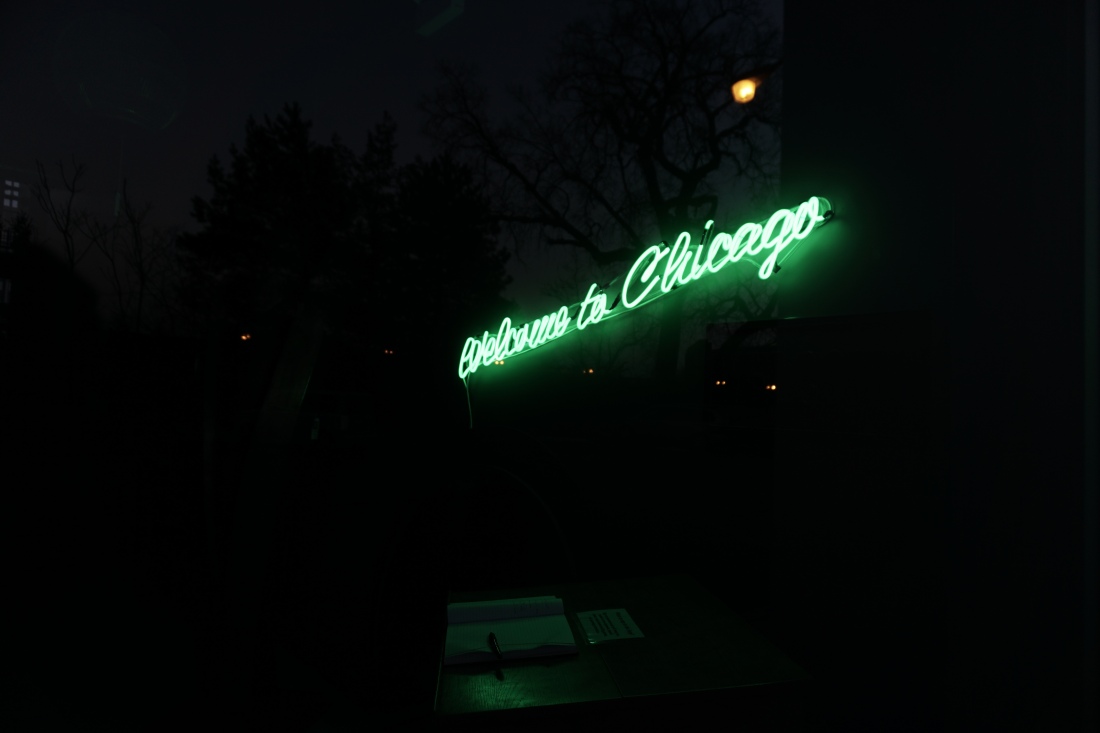
Another gem of the present day Ravenswood Corridor is the aforementioned Lillstreet Art Center. It started in a small warehouse on Lill Street (Avenue) in 1975 and has since grown out of its original space and since 2003 has occupied a large 40,000 square foot building on the corner of Ravenswood and Montrose. The art center is wildly popular as a place to learn everything from ceramics, jewelry making, or printmaking, to digital arts, textiles, and even comic book illustration. It is not just a place to take classes though, as it also houses galleries that feature work from local and national artists. First Slice Cafe, a community focused cafe which donates meals to homeless people in need, is also located in the building on the first floor. It is a true community space.



Just north of the Lillstreet Art Center is Beyond Design Inc., an industrial design firm that transformed an old brick barrel vaulted warehouse for their new facilities in 2007. It was the owner’s vision to purchase the adjacent vacant lot to create an outdoor garden to compliment the newly renovated building. The resulting open space adds much needed greenery and landscaping to the corridor. There is a beautifully restored entrance gate that was provided by Architectural Artifacts. There are also plantings that provide wonderfully colorful displays throughout the year, particularly in the spring as well as a fountain and a large terrace for gatherings.



Perhaps the defining characteristic of the present day Ravenswood Avenue corridor is that it has become rich with a dense concentration of craft breweries and even a whiskey distillery. The building stock, which mainly consists of buildings that were constructed for industrial uses, is very conducive for brewing and there is easy parking and good public transportation nearby; the same favorable conditions that have helped Ravenswood become a successful creative corridor as mentioned above. The momentum from the opening of breweries such as Begyle, Dovetail, Empirical, Band of Bohemia, and others has led the corridor to now be dubbed “Malt Row“.


An important building that exemplifies the Ravenswood Avenue corridor is the Manz Engraving building. Manz Engraving was founded by Jacob Manz, a wood engraver, in 1867. They moved to Ravenswood in 1908, occupying the existing building at 4001 North Ravenswood in 1914. The company is credited with introducing the zinc process and the system of making halftones to the engraving industry. By 1922, the company employed nearly 600 people. The building is a six- story, 90,000 square foot brick structure with a tower on top. With the decline in manufacturing in Chicago in the 1960’s and the socioeconomic changes of the surrounding area, the Manz Corporation vacated the building and moved to the suburbs. While this type of decline caused the Ravenswood neighborhood to lose much of its population and industrial employers over the last few decades, it has also become increasingly wealthy with the expansion of professional jobs. Thankfully, the Manz building was purchased and completely remodeled by Hayes Properties in 2008 and now houses an incredibly wide array of businesses, which highlight the aforementioned changes in the neighborhood. The change in character of the neighborhood and Ravenswood Avenue’s economy is shown more fully in the following charts.




Today there is a very eclectic mix of tenants in the Manz Engraving building: everything from mortgage, realty, IT consulting, marketing, law, and architectural firms to graphic designers, software designers, artist and writing studios, and even a gym and buddhist temple now call the building home.


Perhaps the most iconic building in Ravenswood, the Deagan Unicut building, is another wonderful brick structure with a large clock tower that was built around 1912 at 4201 North Ravenswood. The red brick building has classical details made of limestone and terra cotta. J.C. Deagan, Inc. manufactured musical instruments for bands, musical bells and the “Una-fon” musical keyboard that was used in skating rinks, theaters, and even the Ringling Brothers Circus. They also made the tower, clock, and cathedral chimes that sit atop the building.

Architect F. E. Davidson designed the Deagan building for approximately $150,000 in 1919. The tower on top of the building is a clever way of actually concealing a water tank. Just like others in the area, this building is also now owned by Hayes Properties, which has really helped revitalize and transform the corridor in order to adapt to the 21st century. It’s critical to point out that the buildings have retained their original industrial and manufacturing character because Hayes Properties and others have opted for adaptive reuse of older buildings as opposed to simply tearing them down; this investment in the neighborhood to help retain the character of its built environment should absolutely be commended.

Nearly all of the buildings in the industrial corridor are still in use, whether for industry, art, or business. This collection of buildings illustrate an important part of not only Ravenswood’s history, but the history of industry and light manufacturing in the early 20th century.



The neighborhood hasn’t managed to retain its unique character and adapt to a post-industrial economic landscape solely because of private developers and entities. City intervention has assisted in the ongoing development in Ravenswood, particularly the Ravenswood Corridor. The Ravenswood Corridor between Irving Park and Lawrence is a Tax Increment Finance (TIF) zone with an active Small Business Improvement Fund (SBIF) program, and there are Special Service Areas (SSAs) within the area, which provide expanded services and programs funded through a localized property tax levy that can only be spent within the area that the funds are levied.



Residential Streets
In contrast to the Ravenswood Industrial Corridor, the neighborhood as a whole consists of many fine residential buildings with spacious yards and a whole lot of greenery. From 1868 when the subdivision was first platted, Ravenswood was intended to be an area of fine single family homes and beauty, and in many ways this is still the case.

The area has an abundance of foliage and spacious yards. In the springtime the neighborhood is flooded with bright colors, it is awash in green during the summer, and then slowly transitions to bold reds, oranges, and yellows in the autumn. It even looks pleasant in winter. Also, a portion of the train tracks that run through the heart of the the Ravenswood Avenue corridor are now green: as part of Metra’s landscaping contract for the reconstruction of the Union Pacific North tracks in the area, they provided a community garden along the tracks between Montrose and Berteau.




The existing single family homes in the neighborhood provide excellent examples of the stylistic evolution of late 19th and early 20th century residential architecture. They were primarily built from 1880 to 1920. The earlier homes from the 1880’s are variations of the farmhouse style that include Italianate details. These urban houses from this time period all have gables perpendicular to the street.

The simplest forms of residential architecture from this era are versions of the Chicago cottage, with similar proportions to Greek Revival homes. These houses have various types of ornamentation tacked on for aesthetic purposes, not just exclusively Italianate details. From these relatively simple styles, the houses in the area eventually evolved into Queen Anne and Victorian influenced structures.

Queen Anne style homes became ubiquitous in the country throughout the early 20th century. The Queen Anne style is known for irregular shapes, contrast, eclectic ornamentation, and a variety of bold colors and textures. These distinctions of the Queen Anne style are evident in many of the houses found in Ravenswood.

One of the best examples of the Queen Anne style in the neighborhood is the Abbot House and laboratory at 4605 N. Hermitage, home of the Abbot family and location of the first Abbot laboratory.


When walking around the neighborhood it becomes apparent that the lots in Ravenswood are more spacious than typical lots in Chicago. This can be attributed to folks such as Charles and Eva Linthicum, who moved to the area in 1884. They proposed a number of street improvements in the 1880’s, when Ravenswood had wooden sidewalks, open ditches, and dirt streets. Specifically, they proposed narrowing the streets and creating wide, grassy plots between the sidewalks and curbs. Large Victorian and Queen Anne-style houses sitting on these large plots of land really lend an air of grandeur to the residential streets in the neighborhood.

The late 19th and early 20th century also saw the rise of the Arts and Crafts style, which was defined by symmetry and simplicity as opposed to the complex decorative elements of Queen Anne and Victorian inspired architecture. There are examples of this style in Ravenswood as well.

By the 1920’s and 1930’s single family homes being built in Ravenswood most often were bungalows. Additionally, the multi-family buildings in Ravenswood from this period are of several types – the most common being the two- flat and the six- flat. Two-flats have become synonymous with Chicago architecture, and they are particularly a microcosm of architecture in the city for the period between 1890 and 1930. Two-flats come in many shapes and sizes, ranging from greystones, brick houses, Queen Anne, prairie style flats, and many more.

In Ravenswood, single family homes are intermingled with two and three- flats, six- flats, and courtyard apartment buildings. In some cases, these flats were built to resemble single family homes in an attempt to mask the fact that they are indeed meant for multi-family housing. Due to these varying styles, the built environment of the residential streets in Ravenswood are dynamic and eclectic, allowing for a diversity of residents in the neighborhood.





- One of the oldest residential buildings in Ravenswood, built in 1890. | Frank Kryzak
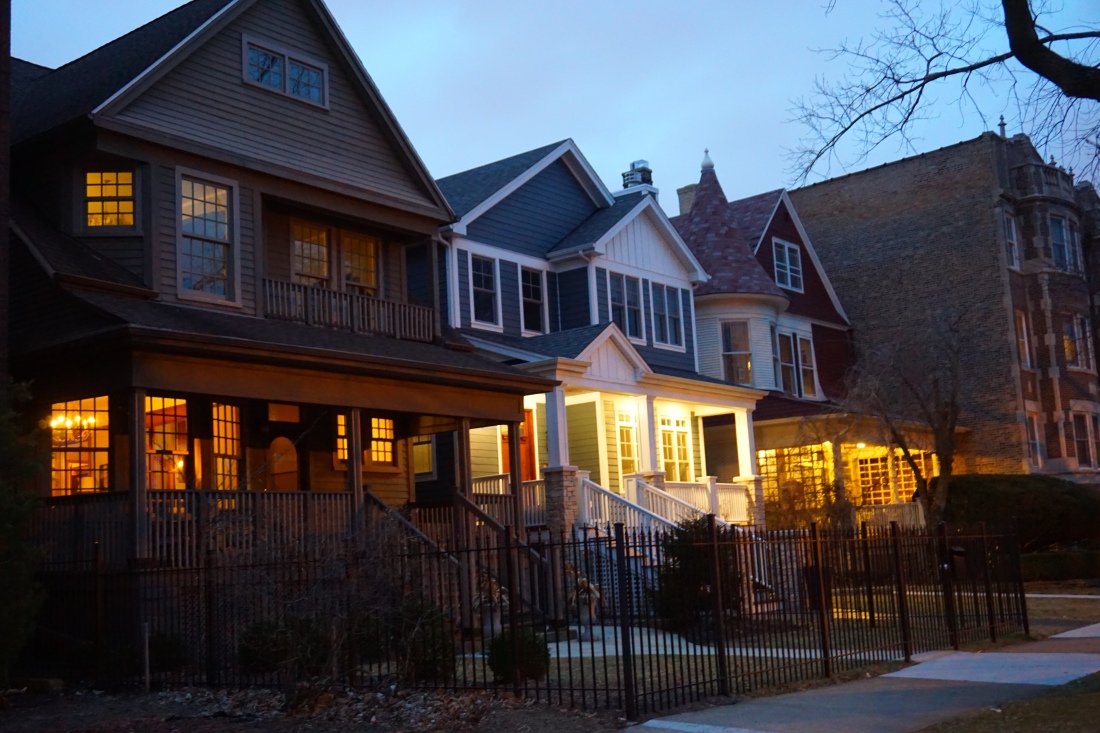
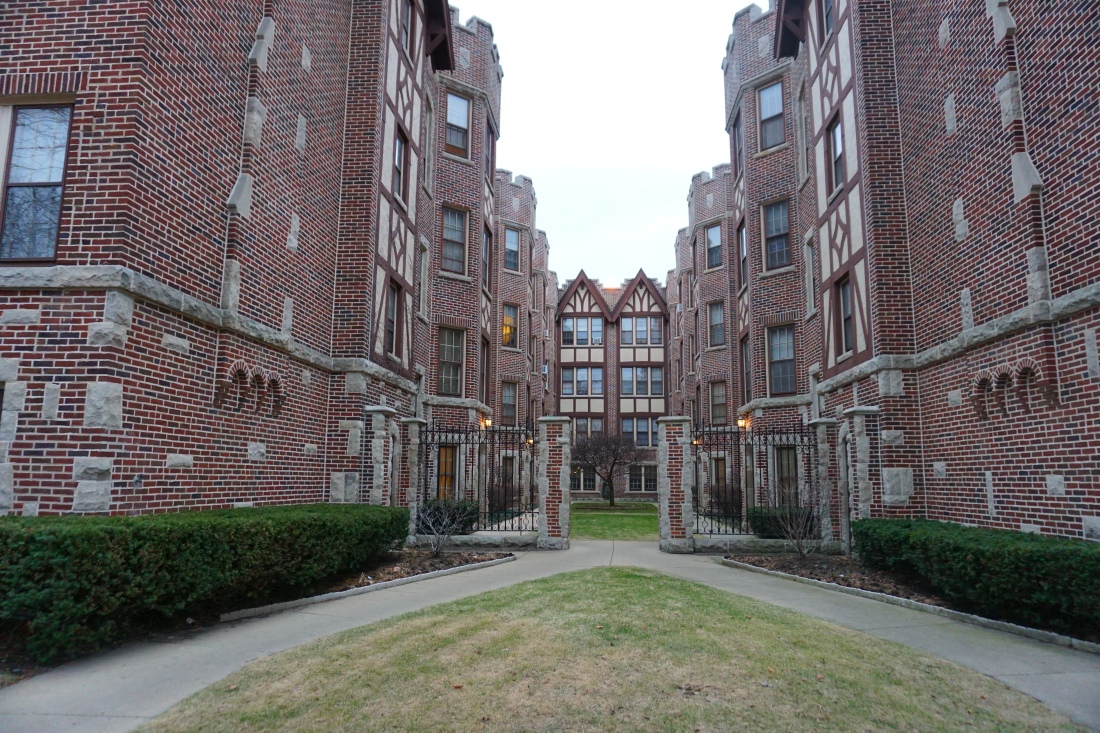
Landscaped courtyard apartment buildings started being built in Chicago in the early 20th century and it was conceived as a way of allowing light and open green space for all residents of a building. These buildings blend in well with the surrounding built environment of the neighborhood but allow for more density, which is crucial in areas with an abundance of single family homes.

The courtyard apartment buildings in Ravenswood are typically three stories on a raised basement, and generally date from the 1920’s. These buildings usually have bays that face the courtyard to add dimension and let more light into the units.

Not all of the housing stock in Ravenswood is from the early 20th century however. On the southeast corner of Hermitage and Wilson and on contiguous lots on Paulina there are townhouses built in the mid 1980’s. The townhouses on Hermitage were built on the site of the Ravenswood YMCA which was founded in 1905. By the 1970’s the building was failing to meet certain building standards and was razed. The resulting prairie-style influenced town homes are integrated well into the neighborhood, even though they are simultaneously unique compared to much of the other building stock.

Religious & Education Buildings
The settlers of Ravenswood were also interested in creating ample educational and religious opportunities for residents. They figured that places to worship and good schools were a way to retain residents and attract other people to the neighborhood. Thus, shortly after Ravenswood was founded, the Ravenswood Land company offered a free lot at Montrose and Hermitage to any congregation who would build a place of worship with no indebtedness. The First Congregational Church of Ravenswood erected the first church in the community in 1869 and it opened in 1870. The congregation eventually closed in 1969 and the building then became home to a hispanic baptist church for a couple decades before closing, but by then Ravenswood had become a community full of churches with beautiful architecture from the late 19th and early 20th centuries.
Located on Wilson and Hermitage, All Saints Episcopal Church is the oldest existing church in Ravenswood. It was built in 1883 by John Cochrane, who also designed the Illinois Statehouse, and is a wood and stucco frame Queen Anne stick style building. Earlier congregations included descendants of Conrad and Christine Sulzer as well as Carl Sandburg when he lived a block away on Hermitage Avenue. The church has gone through some hard times over its history, nearly closing a handful of times due to dwindling attendance as many people moved to the suburbs in the mid 20th century, financial insolvency, several fires, as well as structural decay. The church was designated as a Chicago landmark in 1982 and since then it has recovered financially and has been lovingly restored. It is now the oldest wood frame church still in use in Chicago.



The Ravenswood Methodist Episcopal Church built in 1873 was the second church to be erected in the neighborhood. That building was moved to the northeast corner of Hermitage and Sunnyside where a new church was built in 1890. This building is a made of heavy stone and has a Romanesque design which was popular in the late 19th century for institutional buildings.

In 1913 a unique Spanish Baroque church was built at the southeast corner of Ashland and Leland named Our Lady of Lourdes Church. The building was designed by Worthman and Steinbach Architects, and is made of yellow brick with stone, copper, and tile detailing. It looks quite different from the other Ravenswood churches that existed at that time. Famously, in 1929 the entire edifice was moved across the street to the southwest corner of Ashland and Leland as Ashland was being widened.

In 1917, another unusual and stylistically unique church was built in Ravenswood, the Fourteenth Church of Christ Scientist at Paulina and Sunnyside. It was designed by the architecture firm Dumming and Jensen in the Classical Revival style. They took inspiration from Greek Classical buildings, such as the Pantheon. It is a monumental building consisting of yellow brick and terra cotta ornamentation, with a gabled roof and portico supported by grandiose columns.

Just as Ravenswood is a diverse socio-economic neighborhood, there is also a diverse mix of places of worship. Located on Damen Avenue just north of Montrose is the colorful Chùa Quang Minh Buddhist Temple. These churches, which are within blocks of each other, all represent the time period in which they were built and show that the vision that Ravenswood’s early residents had for their community has endured.

In 1869 the Ravenswood Land Company constructed its first school. It was a one room schoolhouse on the corner of Hermitage and Wilson It was known as the Sulzer school, and was replaced by the Ravenswood School at the corner of Montrose and Paulina in 1873. The school building was remodeled in 1887 and then shortly after that it was replaced by the new Ravenswood School in 1892-93. The original part of the now expanded building was made of red brick with limestone trim and is classically designed. It was added to in 1916 and is one of the oldest elementary school buildings in the Chicago.


Eating, Drinking, & Shopping
Aside from residential and institutional uses, Ravenswood today is a neighborhood that houses some of the city’s finest food, drinking, and shopping. It has matured into a community that can support industrial, creative, and professional uses, high quality residential and institutional structures, as well as an eclectic mix of unique retail and dining businesses. These commercial uses are generally found along Montrose, Damen, Irving Park, and Lawrence but with others near or on Ravenswood Avenue.

One example, Spacca Napoli, is an incredibly popular authentic Neapolitan pizzeria located on Sunnyside and Ravenswood. On warm nights you will find dozens of people eating and drinking outside, congregating on the sidewalk waiting to get into the restaurant, or simply socializing. Even in the winter, Spacca Napoli is generally bursting at the seams with patrons.

Jonathan Goldsmith, Spacca Napoli’s founder, spent a significant amount of time in Naples, Italy learning the craft of pizza making from Italian chefs. Once back in Chicago he founded Spacca Napoli and even had his oven made from imported Italian brick and other materials. It is a place that truly makes one feel as if they have transported to Italy and many go for the experience and warm atmosphere, not to mention the incredible Neapolitan food.

Located further north, and on the west side of Ravenswood Avenue, is Band of Bohemia – a Michelin starred culinary brewhouse. This stretch of Ravenswood, from Leland to Lawrence, across from the Ravenswood Metra station, is in the process of transforming from its industrial roots to a more eclectic mix of commercial and residential uses.

On the southeast corner of Wilson and Ravenswood sits a building that has housed some venerable neighborhood institutions. The Pickard Building was built in the 1890’s to house the artists who hand painted imported white china for the Pickard China Company. Many years later Zephyr Ice Cream was located in the building. Now it houses the popular Irish pub O’Shaughnessy’s Public House.

Zephyr Ice Cream was founded by Byron Kouris, a Greek American who founded the famous Byron’s Hot Dogs in the 1960s, which had locations in Lincoln Park, the Near West Side, and two locations still in operation in Lakeview and Ravenswood (at Paulina and Lawrence). In 1976 he started Zephyr and it was located in the Pickard Building for three decades, closing in 2006.

Just a couple blocks south of the Pickard Building, lies Montrose Avenue – arguably the most successful commercial corridor in the neighborhood. From Ashland to just west of Damen, Montrose is a street with a dense concentration of mixed use residential and commercial buildings. There is a wide array of businesses, many of them locally owned and independent. This certainly gives Montrose Avenue a truly urban and unique character compared to commercial streets in other areas that can now only sustain big box retail for reasons such as sky-high rents.








Although it has no actual defined boundaries and it is not an officially recognized community area, Ravenswood absolutely has an identity all its own. It is the mixture of the Ravenswood Avenue industrial corridor and the beauty of the residential blocks surrounding it that truly makes this neighborhood a unique place. While there are elements to the neighborhood that certainly can be found elsewhere, it is the coalescence of these unique factors- everything from the towering industrial buildings that now house breweries or art centers to the modest two-flats which sit next door to large Victorian mansions and everything in between – that create a vibrant community like no other.
This is a beautiful book about Ravenswood. For clarification, the Graceland West neighborhood and Lake View High School (the oldest high school in Illinois) are in Lake View. Graceland West neighborhood boundaries are Montrose (N), Clark (E), Irving Park and Ashland (W). Graceland West is the only portion of Lake View north of Irving Park. Graceland Cemetery and Arboretum is in Uptown. Coincidently, historians and authors Garry Albrecht, Pat Butler and Matt Nickerson with the Ravenswood – Lake View Historical Association, and PJ Karafiol, Lake View High School Principal led a community discussion for the Graceland West Community Association discussion on “Vintage Lake View” on 3-3-18 and included displays of many Lake View historical items. Response is by GWCA Council. http://www.gracelandwest.org
and Ashland (W). Graceland West is the only portion of Lake View north of Irving Park. Graceland Cemetery and Arboretum is in Uptown. Coincidently, historians and authors Garry Albrecht, Pat Butler and Matt Nickerson with the Ravenswood – Lake View Historical Association, and PJ Karafiol, Lake View High School Principal led a community discussion for the Graceland West Community Association discussion on “Vintage Lake View” on 3-3-18 and included displays of many Lake View historical items. Response is by GWCA Council. http://www.gracelandwest.org
LikeLike
Amazing article! Thank you for the history of this great Chicago neighborhood!
LikeLike
Very nice !
LikeLike
My grandfather designed the Abbot Mansion with his then partner Lievendahl.
Nice photo of the house here. And I love the pie at First Slice!
LikeLike
This was a great write-up. Thank you for the time and effort in putting this together.
LikeLike
This is an amazing piece! I live in Ravenswood and thought I knew everything, but I lived so much. Kudos on such a wonder piece of work.
LikeLike